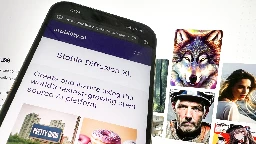AI-generated child sexual abuse images could flood the internet. A watchdog is calling for action
AI-generated child sexual abuse images could flood the internet. A watchdog is calling for action

AI-generated child sexual abuse images could flood the internet. A watchdog is calling for action


I'm not brave enough at the moment to say it isn't some kind of crime, but creating such images (as opposed to spamming them everywhere, using them for blackmail, or whatever) doesn't seem to be a crime that involves any victims.
My bigger concern is the normalization of and exposure to those ideas and concepts (sexualization of children). That’s also why I dislike loli/shota media, despite it being fictional.
That said, I still think it’s a much better alternative to CSAM and especially to actually harming a child for those who have those desires due to trauma or mental illness. Though I’m not sure if easy, open access is entirely safe, either.
The same concern has been behind attempts to restrict/ban violent video games, and films before that, and books before that. Despite generations of trying, I don't think a causal link has ever been established.
For "normalisation of sexualisation of children" go ask the people organizing child beauty pageants.
I'm brave enough to say what I am sure some people are thinking.
If a pedophile can have access to a machine that generates endless child porn for them, completely cutting off the market for the "real thing", then maybe that's a step in a positive direction. Very far from perfect but better than the status quo.
The ideal ultimate solution is to develop a treatment that pedophiles can use to just stop being pedophiles entirely. I bet most pedophiles would jump on such a thing. But until that magical day maybe let's explore options that reduce the harm done to actually real children in the immediate term.
Some psychologists agree with you. Others say it would only make the problem worse, making them want to escalate. Definitely one that I'm letting the professionals debate on and I'll go with their opinion
Some can't be cured by their own admission, its seems for some it is a deep seated sexual deviation that was probably established in very eaely life.
Well, there's all the children whose photos were used for the training data. I'd consider them victims, since AIs can't produce truly new images, so real human victims were needed in order to make AI images possible. And it's been established that AIs need to be trained on new human-made content in order to develop, as the images become distorted when trained on AI-generated content, so unless the paedophiles can be convinced to be satisfied with the AIs as they currently are instead of wanting better/more varied child abuse images next year, a whole lot more real children will need to be abused and photographed in order to improve the AI.
There's a lot of misconceptions about AI image generators in here.
They can indeed generate "truly new images", ask an image generator for an image of something that definitely doesn't exist in its training set and it'll likely be able to come up with something like that for you. Most importantly for purposes of this discussion, you don't actually need to have any images specifically of child abuse in a model's training set in order to train it well enough to produce images of child abuse. Train a model with a bunch of regular porn and a bunch of ordinary images of children and I expect it'll figure out how to make images of children in sexual situations if you ask it to.
This has been known for years. These AIs are capable of "understanding" the things they're trained on and creating novel interpretations of those things.
There was an article recently that showed if you trained many generations of AIs on just the outputs of previous generations you got degraded performance over time, but that's a pretty specific scenario that doesn't match what's being done in real life. In real life synthetic training data (ie, AI-generated training data) can be very useful for expanding the capabilities of AI as long as it's well-curated (humans need to select good outputs and ensure they're described correctly) and ideally has some of the earlier training set's original data included as well.
Another worry could be: how do you know if it’s a real victim who needs help, or an AI generated image.
If we had access to the original model, we could give it the same seed and prompt and get the exact image back. Or, we could mandate techniques like statistical fingerprinting. Without the model though, it's proven to be mathematically impossible the better models get in the coming years - and what do you do if they take a real image, compress it into an embedding, then reassemble it?
Many "AI generated" images are actually very close to individual images from their training data so it's debatable how much difference there is between looking at a generated image and just looking at an image from its training data in some cases at least.
That's a symptom of overfitting, which requires the image to be repeated in the training hundreds or even thousands of times. That generally only happened in earlier image generation models, more "modern" ones ("modern" in this case being measured in months because this is such a fast-developing technology) have much better curation of their training sets to avoid exactly that sort of thing. Nobody wants AI image generators that replicate images from their training sets, what would be the point?
So if you want to find an image model that gives you a close duplicate of an existing image of child abuse, you'll need to find one that was sloppily trained with a training set that included hundreds of duplicates of child abuse imagery. I kind of doubt you'll be able to find one of those.